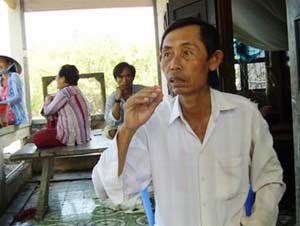We visited the Hưng Nguyên shrimp shell processing factory (Kinh Tắc Hamlet, Hàm Rồng Commune, Năm Căn District, Cà Mau). The unbearable stench hit us immediately; just sitting for a few minutes in Mr. Nguyễn Văn Sáu’s house made our noses sting.
Mr. Sáu expressed his frustration: “For four years, we’ve been inhaling toxic smoke. Everyone in my family now suffers from rhinitis. I was so scared that I had to relocate my two grandchildren to stay with their grandmother in Phú Tân.”
 |
|
Mr. Phạm Văn Đạt lamenting about dead shrimp, heavy losses |
Mr. Sáu led us along Ông Do Hamlet. Everywhere we went, residents were complaining and frustrated about the smoke and dust. Mr. Hà Anh Dũng shook his head when the Hưng Nguyên factory was mentioned: “I can’t eat anymore; the smell makes me want to vomit. It’s extremely uncomfortable, not to mention the flies and insects everywhere…”
The issue of smoke and acid dust from the shrimp shell processing factory has truly become a nightmare for the locals. Within a radius of over 1 km affected by the factory’s emissions, hundreds of people have developed rhinitis, and dozens of families with children have had to relocate elsewhere out of fear of cancer.
The residents of Hàm Rồng and Đất Mới communes in Năm Căn District primarily depend on shrimp farming; however, they claim that since the factory began operations, they have faced continuous crop failures. Mr. Phạm Văn Đạt recounted: “After the factory operated for more than a month, my farmed shrimp began dying, and I kept losing money on shrimp fry. Honestly, I owe the bank 200 million VND now. I heard that the bank has transferred my debt documents to the district court. I might have to appear in court soon.”
Mr. Hà Anh Dũng, Uncle Huỳnh Văn Giữ, Châu Văn Sơn, Phạm Văn Sáu, and Trương Văn Hổ all share the same plight: their shrimp have been dying continuously for the past four years since the factory started. Residents have resorted to selling their land for just 1.5 taels of gold per hectare, down from 3 taels previously, to relocate and seek other livelihoods.
Not only are the shrimp dying, but crabs and fish are also perishing. This situation is horrifying, and the locals are banding together to file lawsuits. However, Mr. Phạm Văn Đạt stated that after sending complaint letters to the district twice without a response, he escalated the matter to the provincial level, yet it still yielded no results.
Mr. Trần Quốc Việt, the manager of the Hưng Nguyên shrimp shell factory, took us on a tour of the facility. Piles of shrimp shells were stacked high. The air in the processing area felt thick with acid fumes and the overpowering stench of decomposing shrimp shells.
The most striking aspect was the hydrochloric acid (HCl) storage tanks. There were seven or eight tanks, each 3 to 4 meters high and more than 1 meter in diameter. Mr. Trần Quốc Việt mentioned that there are a total of 16 chemical treatment ponds for shrimp shells, each with a capacity of about 2.6m3, operating continuously. Each pond has a wastewater discharge pipe connected to a common outlet – with a diameter of 20cm – that discharges directly into the main river.
According to the technical process Mr. Việt outlined, each unit of shrimp shells requires at least two units of chemical water for proper treatment (the factory generates at least 300m3 of hazardous wastewater daily). Over the past four years, the vital river that locals rely on for shrimp farming has been forced to “consume” hundreds of thousands of cubic meters of wastewater containing toxic acids.
Mr. Việt reported that he invested 600 million VND in constructing and installing a wastewater treatment system with a capacity of 300m3/day and plans to complete it by the end of June 2006. However, he admitted that there remains no solution for treating the smoke caused by the acid’s reaction with the shrimp shells during chemical processing.
Therefore, even when Hưng Nguyên’s wastewater treatment system becomes operational, hundreds of households in the Hàm Rồng and Đất Mới communes will still have to continue inhaling concentrated acid fumes.
According to the Cà Mau Department of Natural Resources and Environment, shrimp shell processing factories currently discharge at least 500m3 of wastewater into the rivers in Cà Mau every day. Engineer Ngô Chí Hưng noted that the two chemicals present in high concentrations in this wastewater are HCl and NaOH, both extremely toxic.
NHƯ Ý – Ý NHI

















































